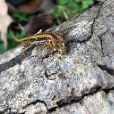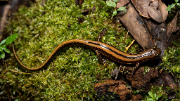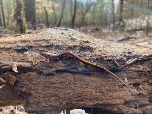Three-Lined Salamander (Eurycea guttolineata)
Description: Eurycea guttolineata is a mid-sized, slender stream salamander which ranges from about 10 to 15.9 cm in its adult form. It is tan to light yellow with three black longitudinal stripes running from the eyes down the length of the body to the tail. The tail is very long at approximately two-thirds its total body length. Additionally, the ventrum (belly) of the three-lined salamander is boldly marked with black and white marbling.
Habitat: Its natural habitats are forested floodplains, ditches, streamsides, and seepages. With wet weather, the species may enter wooded terrestrial habitats. It is not uncommon in suitable habitat. Some subpopulations have likely been extirpated by loss of bottomland hardwood forests.
Range: The species is distributed throughout much of the southeastern United States. It can be found in the Appalachian Mountains from Virginia and Tennessee south through the Carolinas, Georgia, Alabama, and Mississippi to the Gulf Coast, including eastern Louisiana and western Florida
Diet: Three-lined Salamanders feed on a variety of invertebrates including snails, snail eggs, arachnids, millipedes, annelids, nematodes, and many insects. Larvae are thought to feed on small invertebrates, but there have not been any detailed studies on their stomach content or foraging behavior. A study researching the effects of temperature showed that elastically powered tongue-projection performance is maintained to a higher degree than muscle-powered tongue retraction performance across a wide temperature range.
Reproduction: Hatchlings are generally around 10 to 13 mm and undergo metamorphosis when they are 22 to 27 mm snout-to-vent length. This is typically a 4 to 6 month larval stage. The effects that elevation has on larval stages have been studied extensively showing that at lower elevations larvae metamorphosized sooner than those at higher elevations which had delayed metamorphosis mostly due to overwintering. Due to this species being a semi-aquatic salamander in the Plethodontidae family, the females will enter cooler waters in late autumn and winter to drop eggs.
Status: Listed as Least Concern in view of its wide distribution and presumed large population.
»» Kingdom: Animalia - Animals
»» Phylum: Chordata - Chordates
»» Subphylum: Vertebrata - Vertebrates
»» Class: Amphibia - (Amphibians)
»» Order: Caudata - Salamanders
»» Family: Plethodontidae - Lungless Salamanders
»» Genus: Eurycea
»» Species: Eurycea guttolineata - Three-Lined Salamander
This article uses material from the Wikipedia article "Three-Lined Salamander", which is released under the Creative Commons Attribution-Share-Alike License 3.0. Content may have been omitted from the original, but no content has been changed or extended.
|













